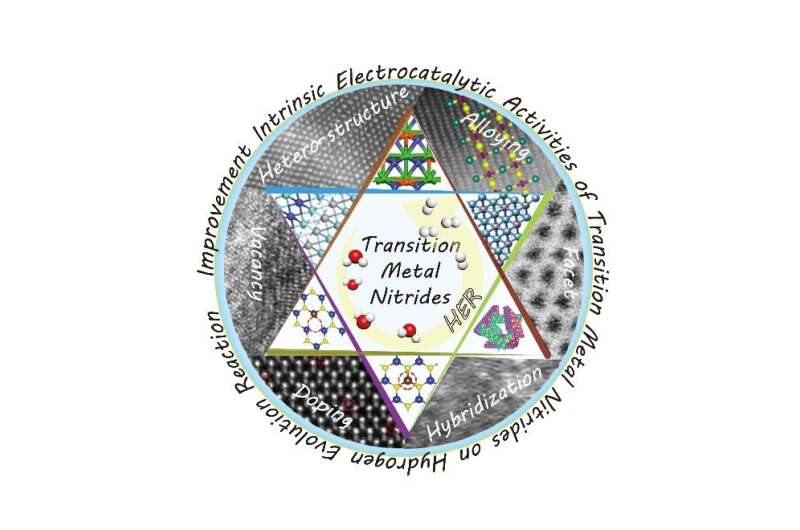Review on intrinsic electrocatalytic activity of transition metal nitrides on HER

A paper published on Dec. 21 in Energy Material Advances reviews improvement strategies for the electrocatalytic activities of transition metal nitrides (TMNs) on hydrogen evolution reaction.
"The electrocatalytic hydrogen evolution reaction (HER) produces considerable hydrogen energy by water splitting without carbon emission, which also plays a key role in the solar-photovoltage and the wind power industry," said paper author Jinfeng Sun, associate professor School of Materials Science and Engineering, Hebei University of Science and Technology.
"TMNs have been considered as Pt-like electrocatalysts for Pt-like electronic structures, resulting in high electronic conductivities, strong chemical stabilities and eminent electrocatalytic activities on HER."
Sun explained that TMNs have several significant advantages as an alternative to Pt-based HER electrocatalysts, especially high metallic conductivities, corrosion resistance and Pt-like d-band structure, which are responsible for intrinsic HER activities.
"Although the electrocatalytic performances of some TMNs have been found more efficient than the original transition metals and other transition metallic compounds, the electrocatalytic activities of TMNs still exist a lot of room for improvement as promising Pt candidates," Sun said.
"Herein, the recent improvement strategies for intrinsic electrocatalytic activities of TMN catalysts on HER by electronic structure modulation were reviewed, such as facet, alloying, doping, vacancy, heterostructure as well as hybridization."
"Anisotropic facets with high energy and isotropic nonfacet with unsaturated coordination effectively expedited the intrinsic actives of TMNs by tailoring the electron structures with d-band center near Fermi level. Compared with crystalline counterparts, the intrinsic electrocatalytic activities of TMNs could be remarkably boosted by electron modulation of unsaturated amorphous structure," Sun said.
"But the control synthesis of desired facets and the exact unsaturated degree as well as the regulation of unsaturated site location were much difficult. Additionally, the atomic configurations of amorphous nonfacet structures were burdensome to determine, arduously revealing HER mechanism."
Sun said the electron density of doping atom was the main influence factor to the electrochemical activities of TMNs. Hetero-doping metal with relatively low d-band electron density (e.g., V or Nb) was the most efficient strategy for intrinsic activity improvement than others. The strategy was limited by the heterogeneous distribution of doping atom, which made model construction and reaction mechanism difficult to explore.
"Much higher electron density of Ni with lower valence state was redistributed near the Fermi level, leading to higher conductivity, stronger H2O adsorption and weaker ∆GH*," Sun said.
"Special treatments (e.g., magnetron sputtering and nitrogen plasma) were usually required for nitrogen vacancy synthesis. Also, it was difficult to control the uniform distribution of nitrogen vacancies. Furthermore, large amounts of vacancies would result in severe lattice distortion, and poor HER activity for TMNs."
"The electronegativity and lattice matching degree of the direct connected components played vital roles to electrochemical activity of heterostructure catalysts," Lin said. "Two components with big differences in electronegativity and crystalline structure (e.g., Co/Co2N/CF or Mo2N/CeO2@NF) resulted in more distinguishing electrocatalytic performances for the faster reaction kinetics, higher electron transfer capacity and stronger lattice strain."
"However, the complicated sequence treatments for heterostructure synthesis restricted its large-scale application. Furtherly, more nanointerface construction in heterostructure was rather difficult to be achieved, which limited the full exploration of heterostructure merits."
Hybridization strategy was one common method for efficient HER electrocatalyst for the facile synthesis without exquisite treatment. The HER kinetics were boosted for the large differences in electronegativity favoring the electron transfer between TMNs and hybridized components. Sun said control of precise regulation with uniform distribution of hybridizations was rather difficult. And the electron transfer between the non-direct contacted components was uncertainty. This made the electrocatalytic mechanism illustration became complicated.
After scrutinizing the researches modulated by six strategies, alloying and heterostructure TMNs were the most widely explored for their high intrinsic activities, Lin said, lots of TMNs heterostructures especially had shown extremely low overpotentials and Tafel slops. The heterostructure of TMN resulted in DGH* much closer to zero, strong H2O adsorption energy and low H2O dissociation energy.
"Although significant breakthroughs for improvement intrinsic activities of TMNs by electronic structure modulation have been made, there is still a lot room for the scale application of TMNs in commercial water electrolyzer," Sun said.
"The future development of TMNs is proposed to focus on developing facile synthesis methods, elucidating regulation mechanism and catalytic mechanism, enhancing activity and stability. Continuous research and development of excellent TMN electrocatalysts on HER should be carried out for the scalable application in industrial water splitting."
More information: Han-Ming Zhang et al, Review on Intrinsic Electrocatalytic Activity of Transition Metal Nitrides on HER, Energy Material Advances (2022). DOI: 10.34133/energymatadv.0006
Provided by Beijing Institute of Technology Press Co., Ltd




















